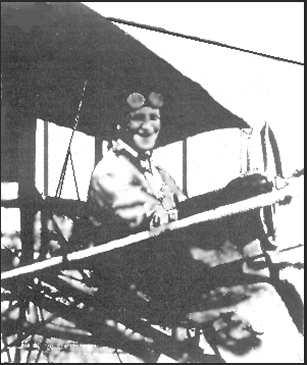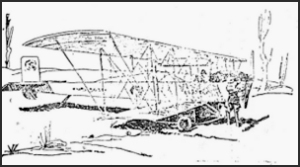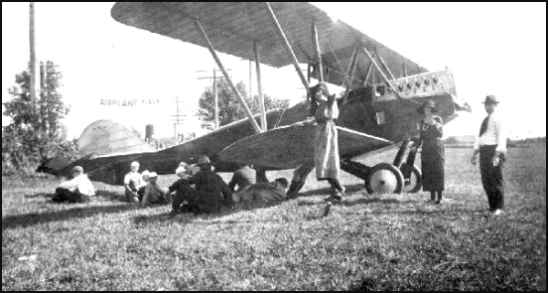
1895-1970 |
 |
The engine and propeller of the "pusher-type" plane were mounted behind him. Courtesy of Karen L. Johnson, 12-3-04 |
|
Self-taught,Munter first flew his "box-kite" craft over his home city in 1912 By CHARLOTTE D. WIDRIG In 1912, Munter soared over Elliott Bay and environs in a homemade airplane that he built and taught himself to fly when he was 17 years old. He then took up exhibition flying around the state, from 1913 to 1915. Race tracks, fairgrounds and cow pastures were his landing fields. Munter became the Boeing Airplane Co's first test pilot in 1915. He remained with Boeing until the end of the First World War. The next two years he did charter flying in the Seattle-Tacoma area. This work was interrupted when fire destroyed his hangar and planes. In 1935, Munter formed the Air Craft Charter Service in Ketchikan. He sold his business in 1941 and served as a Navy flyer in the Sedond World War. His son, Herbert A. Jr., also a Navy pilot was lost in a wartime plane accident. After the war, Munter resumed his career in aeronautics, and with Nick Bez, organized the West Coast Air Lines and became its executive vice-president. Four years ago, the pioneer pilot retired. Now he and his wife, Emma Belle, spend the winters in Mesa, Ariz., and travel in the summer. They have a daughter, Mrs. WIlliam Culver, of Oakland, Calif. Milton Munter, Seattle general contractor and the youngest of six children of the late Mr. and Mrs. J A. Munter, recently recalled some of the exciting adventures of his brother's early life. The Munter family moved to Seattle in 1907, after pioneering for five years in Nome, Alaska. In 1910, Charles K. Hamilton, one of the early birds of aviation on the Pacific Coast , came to Seattle from California, and gave a flight demonstration here. "After watching Hamilton fly, Herb became interested in airplanes," Milton said. "He was working as an apprentice machinist at the Bremerton Navy Yard. From a descriptive article with a plan and front and side views of a Curtiss biplane in Aerial Age magazine, he conceived the idea of building a plane himself." "With money earned at his Bremerton job, Herb purchased materials - bamboo, spruce and unbleached linen--and set out to construct his first airplane in my parent's grocery, two blocks south of Spring Street and 24th Avenue." "At first my mother and father regarded the project merely as something to keep Herb occupied. They became somewhat frightened as the frame neared completion; but at no time did they stand in the way of his dream. When the time came to cover the wings, Mother helped by cutting the cloth on the bias and stitching the strips together on her sewing machine." Milton described the plane as a "sort of large box kite" equipped with a tricycle landing gear. "Four bamboo poles supported the tail, wings, and rear wheels with a couple more poles out front for the front elevator," Milton said. "Spruce struts held the assembly together. "The plane was classed as a 'pusher-type, with the propeller behind a 60-horsepower Hall-Scott water-cooled motor. A bucket seat was attadhed to the landing frame. As time went on, my brother built two more planes of his own design, each a little more modern but with the same horsepower and motor." To read the rest of this fascinating story, click on: |
 |
|
Click here for complete image June 27, 1919 The Centralia celebration committee has arranged a program providing entertainment for every minute of the day. There will be a parade, competition drill between service men, band concerts, sports of every description, and a first-aid contest between two teams of Tono coal miners. There will be a ball game in the morning between Centralia and Pe Ell, the winners to play the Tacoma Beavers in the afternoon. At 7 p. m. exercises will be held marking the demobilization of the city's service flag. A jitney dance, with music by Foley's San Francisco jazz maniacs, will be in progress at the Maple street auditorium afternoon and evening. Cash prizes will be awarded the winners in the sport events and for the best decorated autos and floats in the parade. June 27, 1919 Courtesy of Karen L. Johnson, 12-3-04 |
 |
Collection of Roy Nagl, 3-27-05 |
|
You can visit that reference by clicking on: |
|
Herbert A. Munter, of Walnut Creek, California, a co-founder of West Coast Airlines died Sunday, May 24,
1970 at Pleasant Hill Convalescent Home after a long illness. He had retired in 1958 as Executive Vice President of the airline, now a part of
Air West. At the time of his death, he was 75 years of age. In 1912 Munter was the builder of Seattle's first successful airplane, which he flew. Later he became Boeing Airplane's first test pilot. He flew Boeing's first commercial aircraft in the first flight over Mt. Rainier and operated flying services in Seattle and Alaska, where he served with the Navy during World War II. Surviving are his widow, Emma; a daughter, Lorraine Culver of San Leandro, California and two grandchildren. Funeral services were conducted at Hull's Walnut Creek Chapel. Back 

|